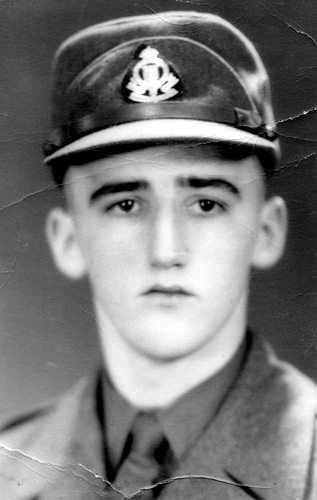 Keeping the Peace
Keeping the Peace
By Tom Lessard
In 1953, I was having a difficult time at my high school, St. Jerome’s in Kitchener. It was an all boys’ school. My grades were bad. I missed a lot of classes and didn’t appreciate the teachers. I’d rather hang out at the pool halls or be caddying at the golf course. I made pretty good money caddying during the summer and setting up pins in the winter, which allowed me to buy my cigarettes, etc.
My 16th birthday was at the end of October, at which time my mother – who was fed up with my shenanigans – told me that if I wasn’t going to go to school full time she would take me to the army recruiting office in Kitchener. It so happened that there were openings for the apprentice-training program. All you had to be was 16 years old. I signed up and my mom co-signed. I received my call up in mid-October. Enclosed was my train ticket and meal tickets to get me to Sunnybrook in Toronto for my physical. About a week later I was ordered to report to the Royal Canadian Ordnance Corps School in Montreal (train and meal tickets again provided).
The apprenticeship included two years education Military Basic Training and group one trades training.
We were the RSM’s favorites in the camp and we could do no wrong. There were officer-training courses going on at the same time; they received all of his wrath.
The majority of the apprentices were borderline troubled kids. But the mess of us turned out all right depending on how you decipher ‘all right.’ Our pay was $49 per month less $17 deduction that included income tax and paying for a blue blazer, gray slacks, white shirt and regimental ties ($5 per month from J.P. Morgans Department Store). We could leave camp during the first year so we didn’t use our civy clothes until second year. It wasn’t much pay, but beer in the taverns was only ten cents a glass, so on Saturday nights a group of us would climb the fence behind the barrack block, take a bus most of the way downtown and find a tavern where no other servicemen were hanging around. Because we were in uniform and the Korean War was just over no one questioned us about age. Two dollars went a long way. No one in our group could handle more than ten glasses at one sitting. We stuck close together and made sure no one got left behind. Getting back over the fence caused a few of us some tears in our clothing but we could always find an excuse when questioned as to why our pants or jackets were sewn up. During the week we had homework sessions from 7 to 9 p.m. but our weekends were free unless we screwed up. There were regular forces N.C.O.C. who trained us in the military aspects of our courses and who also monitored the barrack block. Civilian teachers looked after the academic training.
The two best parts of my two years there were the firing ranges at Mount Bruno outside of Montreal and our driver-training course. Our driving instructor was a WWII vet Sgt. He was quite a guy. Every morning we had to do a thorough inspection of our 3-ton stake truck. The Sgt. insisted that we drink a couple drops from our radiators and taste it to ensure it was antifreeze. We were only kids and didn’t know any better. It was always drilled into our heads never to question a superior. So we didn’t and we tasted the poison.
Most of our driving was done on the back roads of the island where every afternoon coffee break just happened to occur outside a tavern (the Sgt. loved his beer). Anyone without money had to stand guard over the vehicles. As we progressed and became familiar with the trucks and the rules of the road he took us downtown. We never had an accident or a ticket driving during our whole course. It being 1954, there wasn’t near the traffic there is nowadays. It was a great training experience.
When I graduated in 1955 I was posted to 27 Central Ordnance Depot on Highbury Ave in London. I billeted in K Block at Wolseley Barracks, where the 2nd Battalion Royal Canadian Regiment was camped.

